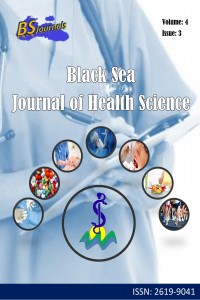Abstract
The approval of local ethics committees is required for clinical researches. In order to obtain approval, how the sample size is determined, whether power analysis is done or not and under what assumptions these analyses are made, are important questions/problems. In hypothesis tests, it is possible two types of errors (type 1 error denoted by α and type 2 error denoted by β), of which α is the probability of rejecting the null hypothesis that is actually true and is the probability of accepting the actually false null hypothesis. These errors also determine the reliability of the test (1-α) and the power of test (1-β). While α is directly determined by the researchers and generally as taken 0.05 (in some cases 0.01), β cannot be determined directly. Because β, hence the power of test (1-β) depends on the α (negatively correlated with β) the variation in the population (positively correlated with β) and sample size (n; negatively correlated with β). In clinical researches, it is required that β does not exceed 0.10 (in some cases 0.05) so the power of test should be at least 0.90 and above. In this study, the sample sizes required for some statistical tests (independent sample t-test, one-way ANOVA and Chi-square) which are widely used in clinical research, were calculated with the G*Power program and some evaluations were made. As a result, as expected in the statistical tests, it was observed that decreasing both α and effect size and increasing the power of the test significantly increased the required sample size. However, it was also observed that increasing effect on the sample size of increasing the power of test decreased (5-11%) in the smaller values of α in the independent sample t-test, decreased (nearly 5%) when increasing the number of compared groups in one-way ANOVA and decreased (10-15%) when increasing degree of freedom of Chi-square test.
Supporting Institution
-
Project Number
-
References
- Anonymous 2020a URL: https://www.titck.gov.tr/faaliyetalanlari/ilac/klinik-arastirmalar (access date: September 20, 2020).
- Anonymous 2020b. URL: https://ikua.saglik.gov.tr/TR,259729/klinik-arastirma-nedir.html, (access date: September 20, 2020).
- Cohen J. 1988. Statistical power analysis for the behavioral sciences. Hillsdale, Lawrence Erlbaum Associates, New Jersey, USA, 567 pages.
- Faul F, Erdfelder E, Lang AG, Buchner A. 2007. G*Power 3: A flexible statistical power analysis program for the social, behavioral, and biomedical sciences. Behav Res Methods, 39(2): 175-191.
- Faul F, Erdfelder E, Buchner A, Lang AG. 2009. Statistical power analyses using G*Power 3.1: Tests for correlation and regression analyses. Behav Res Methods, 41(4): 1149-1160.
- Kalaycıoğlu O, Akhanlı SE. 2020. Sağlık araştırmalarında güç analizinin önemi ve temel prensipleri: Tıbbi çalışmalar üzerinde uygulamalı örnekler. Turk J Public Health, 18(1): 103-112.
Abstract
Project Number
-
References
- Anonymous 2020a URL: https://www.titck.gov.tr/faaliyetalanlari/ilac/klinik-arastirmalar (access date: September 20, 2020).
- Anonymous 2020b. URL: https://ikua.saglik.gov.tr/TR,259729/klinik-arastirma-nedir.html, (access date: September 20, 2020).
- Cohen J. 1988. Statistical power analysis for the behavioral sciences. Hillsdale, Lawrence Erlbaum Associates, New Jersey, USA, 567 pages.
- Faul F, Erdfelder E, Lang AG, Buchner A. 2007. G*Power 3: A flexible statistical power analysis program for the social, behavioral, and biomedical sciences. Behav Res Methods, 39(2): 175-191.
- Faul F, Erdfelder E, Buchner A, Lang AG. 2009. Statistical power analyses using G*Power 3.1: Tests for correlation and regression analyses. Behav Res Methods, 41(4): 1149-1160.
- Kalaycıoğlu O, Akhanlı SE. 2020. Sağlık araştırmalarında güç analizinin önemi ve temel prensipleri: Tıbbi çalışmalar üzerinde uygulamalı örnekler. Turk J Public Health, 18(1): 103-112.
Details
| Primary Language | English |
|---|---|
| Subjects | Clinical Sciences |
| Journal Section | Research Article |
| Authors | |
| Project Number | - |
| Publication Date | September 1, 2021 |
| Submission Date | January 22, 2021 |
| Acceptance Date | March 17, 2021 |
| Published in Issue | Year 2021 Volume: 4 Issue: 3 |


